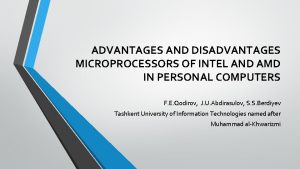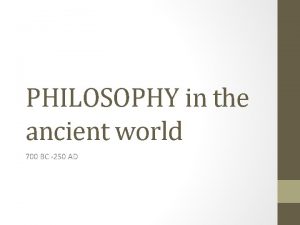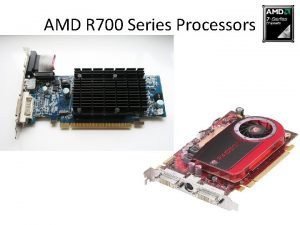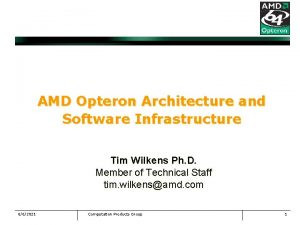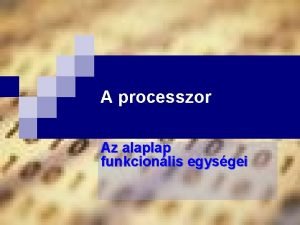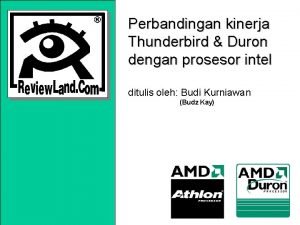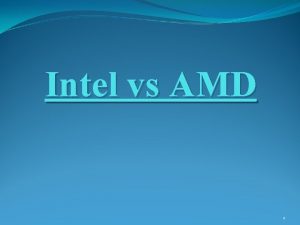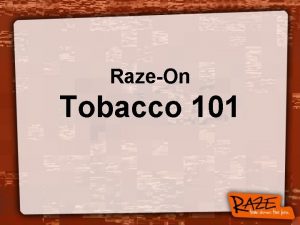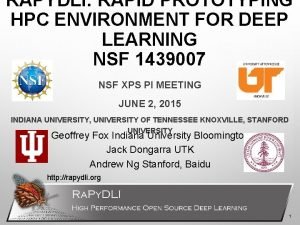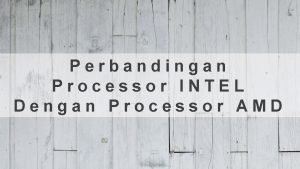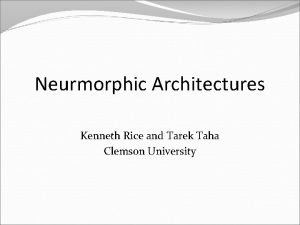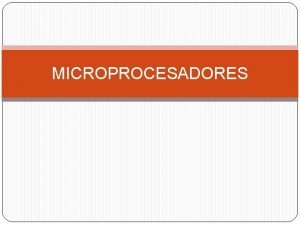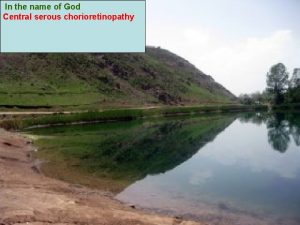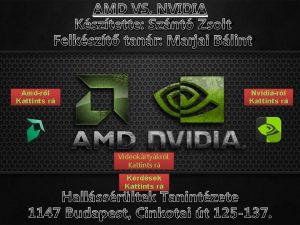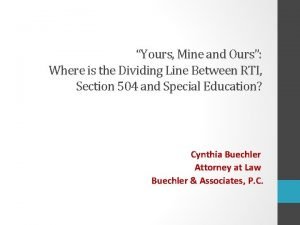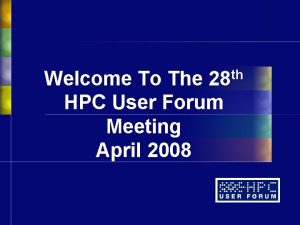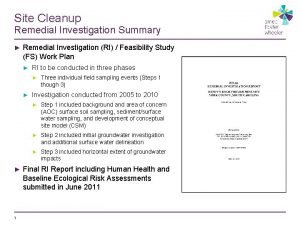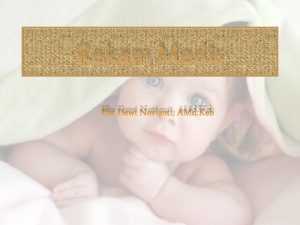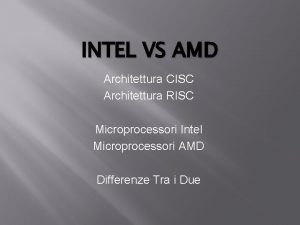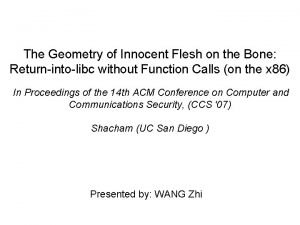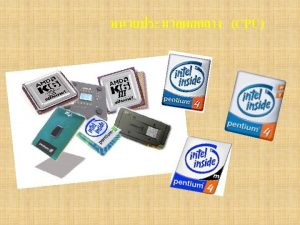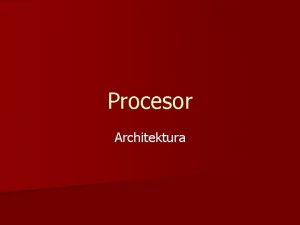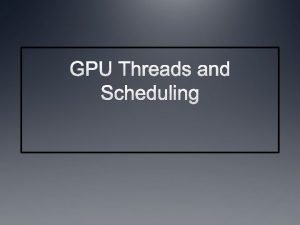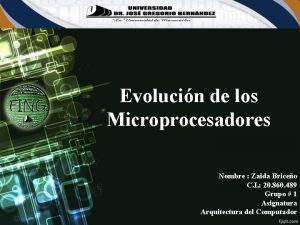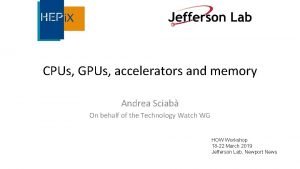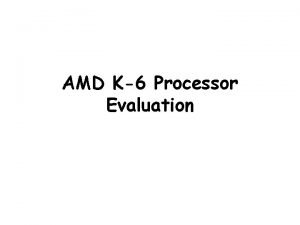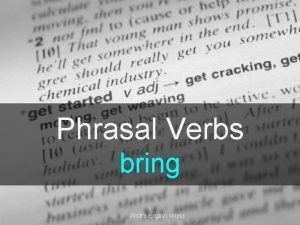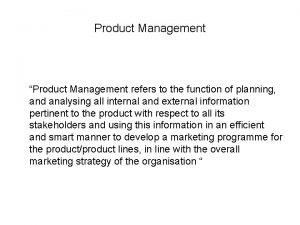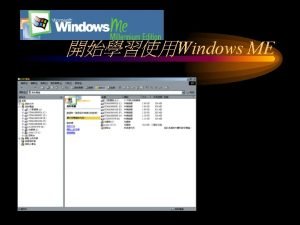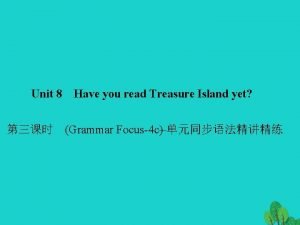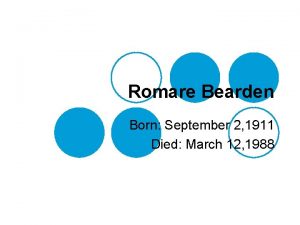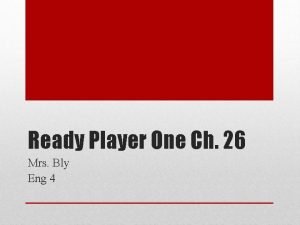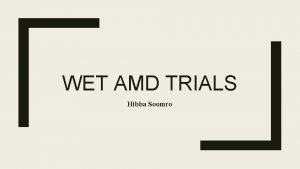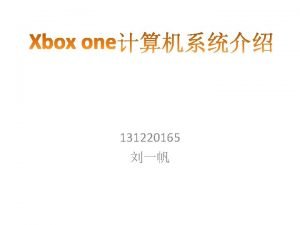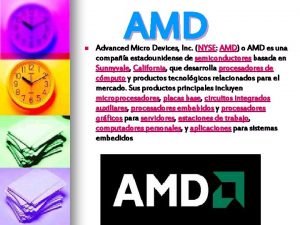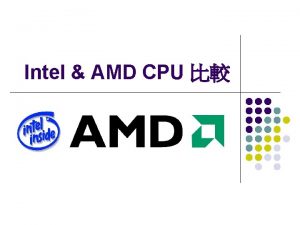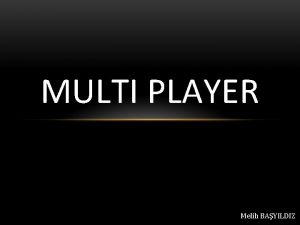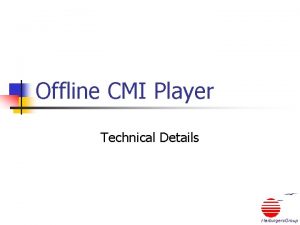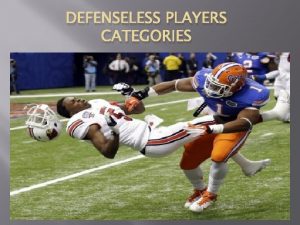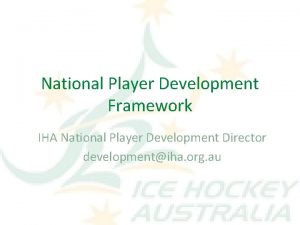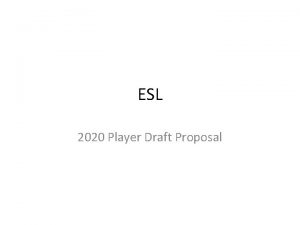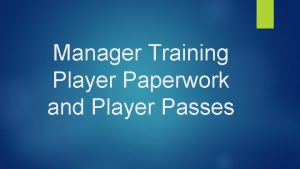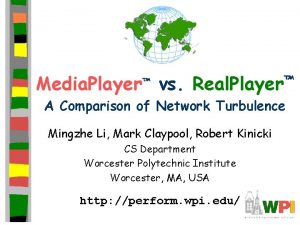AMD management what changes with a new player



























































- Slides: 59

AMD management: what changes with a new player? Sobha Sivaprasad

Disclosures • Research grants, travel grants, speaker fees and advisory board member of: Novartis, Bayer, Allergan, Roche.

Overview • Current treatment option for neovascular AMD – ranibizumab and bevacizumab • Real-life experience • New player- aflibercept

Choroidal Neovascularisation Anti-VEGF therapy de st ru ct io n Laser Photocoagulation Photodynamic Therapy Surgical excision modulation Transpupillar Thermotherapy Radiotherapy Schmidt-Erfurth and Pruente, 2007

VEGF-A and neovascular AMD Initiating stimuli VEGF imbalance Pro-inflammatory Pathologic neovascularization Subretinal fibrosis Disruption of retina Increased Permeability • Anti-VEGF treatment targets the protein responsible for the hallmarks of neovascular AMD • In neovascular AMD, blockage of pathologic VEGF-A does not block stimuli Lee et al. , 2005 Ng et al. , 2006

Ranibizumab trials – Mean changes in visual acuity ANCHOR MARINA +11. 3 ETDRS letters +7. 2 – 9. 5 20. 8 letter difference* 17. 6 letter difference* -10. 4 Monthly injections (0. 5 mg) Month Brown et al. , 2006 Rosenfeld et al. , 2006

CATT 2 year results

Real-life results do not match VA improvements seen in clinical trials Study Description Number of patients enrolled Mean VA change from baseline to Year 1 AURA 1 Retrospective, non-interventional, observational, multicentre study 474 (UK) 6. 0* Medisoft 2 Multicentre, national n. AMD database study 11, 135 2 ANCHOR 3 Multicentre, 2 -year, double‑blind study 423 11. 3† MARINA 4 Multicentre, 2 -year, double‑blind study 716 7. 2† *UK-based patients. †Patients receiving 0. 5 mg ranibizumab. ‡Treatment-naive patients. ETDRS, Early Treatment Diabetic Retinopathy Study; F-U, follow-up; n. AMD, neovascular age-related macular degeneration; VA, visual acuity. 1. Holz FG et al. EURETINA September 2013. 2. Writing Committee for the UK Age-Related Macular Degeneration EMR Users Group. Ophthalmology 2014; 121: 1092– 1101. 3. Brown DM et al. N Engl J Med 2006; 355: 1432– 1444. 4. Rosenfeld PJ et al. N Engl J Med 2006; 355: 1419– 1431. 5. Pushpoth S et al. Br J Ophthalmol 2012; 96 (12): 1469– 1473.

AURA Study Design • Retrospective, noninterventional, observational, multicentre study conducted in Canada, France, Germany, Ireland, Italy, the Netherlands, United Kingdom, and Venezuela – Data from patients’ medical records and results from examinations/ assessments performed during routine clinical practice were evaluated – >100 centres included – Target enrolment = 444 patients per country Retrospective FPFV = Jan 1, 2009 LPFV = Aug 31, 2009 Start of anti-VEGF therapy with ranibizumab LPLV = Aug 31, 2011 Follow-up (2. 5 years) Sep 31, 2012 Data collection FPFV, first patient first visit; LPFV, last patient last visit; LPLV, last patient last visit; VEGF, vascular endothelial growth factor. 9

Changes From Baseline VA Declined Following an Initial Improvement* • In all countries, mean VA declined following an initial improvement Mean letter change in VA score from baseline (LOCF) 8 6 4 2 0 0 1 2 3 4 5 6 7 8 9 101112131415161718192021222324 -2 Months -4 *Effectiveness 10 baseline and ≥ 1 post-baseline assessment of VA for the treated eye). set (all patients who ≥ 1 VA assessment for treated eye at

MEDISOFT ‘real-life’ Lucentis data demonstrates disadvantages of a reactive treatment regime Within 3 years of starting therapy all of initial VA gains are lost

Anti VEGF A monotherapy • Good clinical trial results • Real-life results remain suboptimal • Optimal dosing frequency and duration of therapy unknown • Prolonging the natural history to fibrosis/ atrophy.

VEGF FAMILY Sun W. B J Hematol Oncol. 2012; 5: 63.

Aflibercept –recombinant fusion protein

VEGF-R DECOY

Multi-ligand target

PLGF De Falco S. Exp Mol Med. 2012 ; 44(1): 1 -9.

VEGF-B • The role of VEGF-B in endothelial angiogenesis is not fully understood. • As with VEGF-A and PLGF, VEGF-B also binds VEGFR-1 • Not a classical pro-angiogenic agent • Blood vessel survival factor (endothelial cell mitogen) • A role in cell adhesion and migration has also been proposed. Olofsson B Proc Natl Acad Sci U S A. 1998 Sep 29; 95(20): 11709 -14.

Unique Binding Mechanism of Eylea® “Two hands on a ball” VEGF VEGF Ranibizumab VEGF Bevacizumab VEGF Eylea® Affinity maturation VEGF VEGF VEGF VEGF VEGF Bevacizumab can “daisy-chain” or “paper-doll” with VEGF leading to large, multimeric conglomerates 1: 1 stoichiometric binding VEGF Two ranibizumab molecules can bind each VEGF dimer 19

Differences in Anti-VEGF agents Ranibizumab Bevacizumab Aflibercept Molecule Fab Full –sized Mab Fusion protein Binds VEGF -A VEGF-A VEGA-A, B and PIGF Fc No Yes Mol wt 48 k. Da 149 k. Da 115 k. Da 27 -38 days 83 days Intravitreal VEGF binding 30 days activity (Mathematical model)

Why is VEGF Trap more potent? • onsequence of its higher affinity for human VEGF • VEGF-Trap may be able to more completely block the human VEGF derived from the implanted human tumors. • May be because of its ability to bind VEGF family members other then VEGF A, such as placental growth factor and VEGF B • Therefore, a more complete blockade of neovessels than just a disruption.

VIEW Studies: Mean Change in Visual Acuity Baseline to Week 96

Approved treatment of wet AMD Dosing schedule Loading dosing Maintenance dosing Treat-andextend dosing AMD, age-related macular degeneration. Treatment period (months) 0– 3 Description 4– 12 Patients receive one injection every two months The treatment interval may be extended based on visual and anatomic outcomes 12+ EYLEA® treatment is initiated with one injection per month for three consecutive doses

EFFECTIVE DRYING AGENT

Case 1: 73 -year-old male with predominantly classic CNV (LE) • History – 26 ranibizumab injections from 15 -Sep-2008 – VA 41 letters on 07 -Mar-2013 • First EYLEA injection given

• At 4 -week review – VA 40 – Followed-up without treatment

• At 8 -week review – VA 41 – Minimal SRF – Second dose of EYLEA given

Case 2: 80 -year-old male with occult CNV LE • History – Treated with 6 consecutive ranibizumab – persistent SRF LE – VA 43 • First injection of EYLEA given

• At 4 -week review – VA 43 – Second injection of EYLEA given

• At 8 -week review – VA 45 – Third injection of EYLEA given

Case • Re 24 inj Lucentis from Apr 2011 • ETDRS letters from 58 post lucentis • Resistant case

Lucentis 24 Inj VA 58 4 weeks Post Eylea VA 62

Inhibition of neuroblastoma tumors by anti-VEGF agents. Kim E et al Proc Natl Acad Sci U S A. Aug 20, 2002; 99(17): 11399– 11404

Escape Phenomena • Increased VEGF after anti-VEGF therapy is likely to be a host-response to neutralizing such a critical growth factor. • Increased PLGF in seen in patients on anti. VEGF agents – predictive biomarker of antiangiogenic response! • Targeting PLGF will prevent tumor escape from anti-VEGF therapy

EFFECTIVE in PEDs

Case • 73 year old lady referred by the Optician when patient attended for routine refraction • HT and T 2 DM 10 years on treatment • H/o previous laser BE for DM 2 years back • VA RE -26 letters (5/60) LE- 88 (6/6) • IOP 12 mm. Hg 12

Case: RE baseline VA 26 1 st treatment- Eylea • VA 26 to 39

SD OCT • VA 26 to 39 Large PED with IRF

FFA ICGA

4 weeks Post Eylea X 1 VA 35 Decreased height of PED

8 weeks Post Eylea X 3 VA 40 • Patient on Inj Eylea RE 8 weekly

PED and VEGF-R • UNCLEAR • VEGF receptor 2 (VEGFR 2) is primarily expressed in nonvascular photoreceptors and ganglion cells. • VEGF receptor 1 (VEGFR 1) is expressed in vascular endothelial cells and pericytes. Cao R Proc Natl Acad Sci U S A. 2010 Jan 12; 107(2): 856 -61 • VEGF receptor 1 (VEGFR 1) is a key modulator of angiogenic potential in RPE cells of the human retina Akrami H et al. Graefes Arch Clin Exp Ophthalmol. 2011 Apr; 249(4): 537 -46

RPE barrier and PIGF • Pl. GF-1 and VEGFR-1 pathway regulation of the external epithelial hemato-ocular barrier. A model for retinal edema. Miyamoto N et al. Ophthalmic Res. 2008; 40(3 -4): 203 -7.

Heterogeneity of response • 20% of the patients will require 4 weekly aflibercept. • No predictive factors identified. • Non-responders to Aflibercept exists. • Poor responder • Good responder • Unknown angiogenic driver.

Case • 81 year old lady with RAP RE • Developed intense vitritis RE following 2 nd and 3 rd dose of Lucentis • Treated with IVTA subsequently • VA- 59

• 4 week review following 1 st Eylea • VA - 80 Patient not keen on repeat treatment

• 8 week review following 1 st Eylea • VA – 69 Treated with Inj Eylea

• 12 week review • VA – 76 Treated with Inj Eylea

Case: 76 year old lady with occult CNV • History – 30 previous ranibizumab injections (LE) – VA 55 • First injection of EYLEA given

• At 4 -week review – VA 54 – Second injection of EYLEA given

• At 8 -week review – VA 57 – Third injection of EYLEA given

• At 12 -week review – VA 51 – Fourth injection of EYLEA given

Case • 69 year old male under the AMD clinic since 18 months on Inj Lucentis X 12 RE • VA RE 63 LE 88 (6/6)

Inj Lucentis X 12 VA 63 • Commenced on Inj Eylea RE

Inj Eylea X 1 4 week review VA - 64 • 2 nd dose of Eylea given RE

Inj Eylea X 4 consecutive VA 60 • Pt observed

Safety of Aflibercept • Systemic aflibercept after intravitreal aflibercept injection = 0. 019µg/ml • Current evidence suggests that hypertension is a pharmacodynamic effect of anti-angiogenic agents in cancer therapy. • Predictive factor for oncologic response. • Target HT response is – 2. 91µg/ml

Conclusions • Aflibercept is effective and safe in patients with wet AMD • Provides choice for our patients. • Cost-effective as per NICE TA 294. • Useful in treatment naïve and switch patients. • More studies (clinical and lab) are required.

Published papers- References: 1. 2. 3. 4. 5. 6. 7. Chang et al. Intravitreal Aflibercept for Treatment- Resistant Neovascular Age-Related Macular Degeneration. Ophthalmology 2013. Published online first. Kumar N et al. Visual and Anatomical Outcomes of Intravitreal Aflibercept in Eyes With Persistent Subfoveal Fluid Despite Previous Treatments With Ranibizumab in Patients With Neovascular Age-Related Macular Degeneration. RETINA. March 2013. doi: 10. 1097/IAE. 0 b 013 e 31828 e 8551. Abstract available at: http: //journals. lww. com/retinajournal/Abstract/publishahead/Visual_and_Anatomical_Outcomes_of_Intr avitreal. 98732. aspx Cho et al. Aflibercept for exudative AMD with persistent fluid on ranibizumab and/or bevacizumab. Br J Ophthalmol 2013; 0: 1– 4. doi: 10. 1136/bjophthalmol-2013 -303344 Yonekawa et al. Conversion to Aflibercept For Chronic Refractory Or Recurrent Neovascular Age-Related Macular Degeneration. Am J Ophthalmol. 2013. http: //dx. doi. org/10. 1016/j. ajo. 2013. 030 Ho et al. Short-Term Outcomes of Aflibercept for Neovascular Age-Related Macular Degeneration in Eyes Previously Treated With Other Vascular Endothelial Growth Factor Inhibitors. Am J Ophthalmol 2013. http: //dx. doi. org/10. 1016/j. ajo. 2013. 02. 009 Patel KH et al. Rapid response of retinal pigment epithelial detachments to intravitreal aflibercept in neovascular age-related macular degeneration refractory to bevacizumab and ranibizumab. Eye advance online publication 5 April 2013; doi: 10. 1038/eye. 2013. 31. Available at: http: //www. nature. com/eye/journal/vaop/ncurrent/full/eye 201331 a. html Bakall et al. Aflibercept Therapy for Exudative Age-related Macular Degeneration Resistant to Bevacizumab and Ranibizumab. Am J Ophthalmol 2013.
 Elizabeth mulroney
Elizabeth mulroney Example of a chemical change
Example of a chemical change Hasil penggosokan yang benar adalah
Hasil penggosokan yang benar adalah Amd akupunktur
Amd akupunktur Advantages and disadvantages of intel processors
Advantages and disadvantages of intel processors Amd bc-250
Amd bc-250 Amd farm
Amd farm Amd r700
Amd r700 Tim wilkens
Tim wilkens Ben sander
Ben sander Intel processzorok jelölése
Intel processzorok jelölése Intel duron
Intel duron Amd vs intel history
Amd vs intel history Amd v technology
Amd v technology Razeon
Razeon Amd machine learning
Amd machine learning Tulisan amd
Tulisan amd Amd rome processor
Amd rome processor Microprocesador introduccion
Microprocesador introduccion Wet amd
Wet amd Kapcsa zsolt
Kapcsa zsolt Yours mine amd ours
Yours mine amd ours Amd hpc user forum
Amd hpc user forum For amd
For amd Tulisan amd rmik
Tulisan amd rmik Differenza tra intel e amd
Differenza tra intel e amd The geometry of innocent flesh on the bone
The geometry of innocent flesh on the bone Socket pga
Socket pga Procesory amd wikipedia
Procesory amd wikipedia Amd gpu scheduling
Amd gpu scheduling Nombre
Nombre A64fx fujitsu
A64fx fujitsu Amd k 6
Amd k 6 Animal farm chapter 10
Animal farm chapter 10 Bring proff
Bring proff Changes affecting product management
Changes affecting product management Pyramid levels of management
Pyramid levels of management Management pyramid
Management pyramid Top level management
Top level management Split speech punctuation
Split speech punctuation New york, new jersey, pennsylvania, and delaware
New york, new jersey, pennsylvania, and delaware New oil and new wineskin
New oil and new wineskin Movie theater new hartford ny
Movie theater new hartford ny Strengths and weaknesses of the articles of confederation
Strengths and weaknesses of the articles of confederation New-old approach to creating new ventures
New-old approach to creating new ventures New marketing realities pdf
New marketing realities pdf Njbta
Njbta New classical macroeconomics
New classical macroeconomics Chapter 16 toward a new heaven and a new earth
Chapter 16 toward a new heaven and a new earth Neil thisse is a loyalist answers
Neil thisse is a loyalist answers New classical and new keynesian macroeconomics
New classical and new keynesian macroeconomics Roosevelt vs taft progressivism venn diagram
Roosevelt vs taft progressivism venn diagram Windows media player 7
Windows media player 7 Vw als global player
Vw als global player Monika kovak is a tennis player
Monika kovak is a tennis player Who being an effective team player
Who being an effective team player Line judge volleyball signals
Line judge volleyball signals When was romare bearden born
When was romare bearden born Who are the gods of the north ready player one
Who are the gods of the north ready player one Leopardon ready player one
Leopardon ready player one




